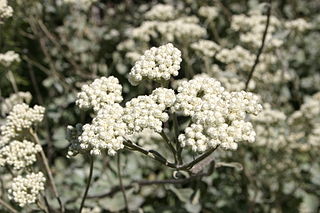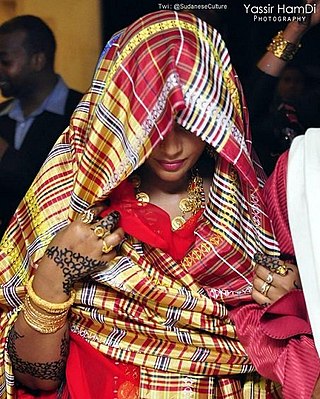Related Research Articles
Muthi is a traditional medicine practice in Southern Africa as far north as Lake Tanganyika.

Scarification involves scratching, etching, burning/branding, or superficially cutting designs, pictures, or words into the skin as a permanent body modification or body art. The body modification can take roughly 6–12 months to heal. In the process of body scarification, scars are purposely formed by cutting or branding the skin by various methods. Scarification is sometimes called cicatrization.
Infibulation is the ritual removal of the vulva and its suturing, a practice found mainly in northeastern Africa, particularly in Djibouti, Eritrea, Ethiopia, Somalia, and Sudan. The World Health Organization refers to the procedure as Type III female genital mutilation.
Hilot (/HEE-lot/) is an ancient Filipino art of healing. It uses manipulation and massage to achieve the treatment outcome, although techniques differ from one practitioner to another. It emerged from the shamanic tradition of the ancient Filipinos with healers considering their practice as derived from their calling from visions or from having been born by breech.
The material culture of the Manasir is very basic and primarily relies on the by-products of palm tree cultivation. Date trees not only constitute the main source of income and an important supply of nutrition in Dar al-Manasir, but the Manasir also make intelligent use of all different parts of the palm tree. From it they produce diverse household items, garden tools and building material for their traditional mud houses..
The Quijos-Quichua (Napo-Quichua) are a Lowland Quechua people, living in the basins of the Napo, Aguarico, San Miguel, and Putumayo river basins of Ecuador and Peru. In Ecuador they inhabit in the Napo Alto as well as the rivers Ansuy and Jatun Yacu, where they are also known as Quijos Quechua. The Quijos Original Nation (NAOKI) has an extension of community territory of approximately 13,986, 78 hectares. It was recognized as such on March 13, 2013, by Codenpe. It is made up of dozens of groups, communities and organizations, according to their status.

Helichrysum petiolare, the licorice-plant or liquorice plant, is a species of flowering plant in the family Asteraceae. It is a subshrub native to the Cape Provinces of South Africa — where it is known as imphepho — and to Angola, Zambia, and Zimbabwe. It is naturalized in parts of Portugal and the United States. Growing to about 45 cm (18 in) high and 150 cm (59 in) broad, it is a trailing evergreen subshrub with furry grey-green leaves and small white flowers. Other common names include silver-bush everlastingflower, trailing dusty miller and kooigoed. The foliage has a faint licorice aroma, but Helichrysum petiolare is not closely related to true liquorice, Glycyrrhiza glabra, from which liquorice candy is made.

A folk healer is an unlicensed person who practices the art of healing using traditional practices, herbal remedies, and the power of suggestion. The term "folk" was traditionally associated with medical and healing practices that weren't explicitly approved by the dominant religious institution. If people didn't seek healing from an approved priest or religious figure, they would seek the help of the local folk healer. Folk healers, despite their technical illegitimacy, were often viewed as being more involved with the healing process and made their patients more comfortable than other practitioners. With modern medicine being preferred, some look towards folk healers to get consoled from the sacred use of traditional medicine. "Appalachian folk healing goes by many names, depending on where it’s practiced in the region and who’s doing the practicing: root work, folk medicine, folk magic, kitchen witchery."
Maya medicine concerns health and medicine among the ancient Maya civilization. It was a complex blend of mind, body, religion, ritual and science. Important to all, medicine was practiced only by a select few, who generally inherited their positions and received extensive education. These shamans acted as a medium between the physical world and spirit world. They practiced sorcery for the purpose of healing, foresight, and control over natural events.

In the cultures of the Horn of Africa and adjacent regions of the Middle East, Zār is the term for a demon or spirit assumed to possess individuals, mostly women, and to cause discomfort or illness. The so-called zār ritual or zār cult is the practice of reconciling the possessing spirit and the possessed individual. Zār possession is often considered lifelong and the rituals associated with it are a form of adorcism, though some have falsely attributed it as an exorcism rite because it involves possession. It is similar to the Maghreb's Hamadsha, Hausa Animism, and various African Traditional religions, such as Voodou.

Smoking ceremony is an ancient and contemporary custom among some Aboriginal Australians that involves smouldering native plants to produce smoke. This herbal smoke is believed to have both spiritual and physical cleansing properties, as well as the ability to ward off bad spirits. In traditional, spiritual culture, smoking ceremonies have been performed following either childbirth or initiation rites involving circumcision. In contemporary culture, elements of smoking ceremonies have been incorporated into Welcome to Country performances and other spiritual events held for the general public.
Ramuan is an Indonesian-Malay term referring to a blend of ingredients selected to provide health benefits in the preparation of food or the creation of herbal medicines. Ramuan may consist of leaves, stems, barks, fruits and roots, traditionally gathered from the rainforest.

Aztec medicine concerns the body of knowledge, belief and ritual surrounding human health and sickness, as observed among the Nahuatl-speaking people in the Aztec realm of central Mexico. The Aztecs knew of and used an extensive inventory consisting of hundreds of different medicinal herbs and plants. A variety of indigenous Nahua and Novohispanic written works survived from the conquest and later colonial periods that describe aspects of the Aztec system and practice of medicine and its remedies, incantations, practical administration, and cultural underpinnings. Elements of traditional medicinal practices and beliefs are still found among modern-day Nahua communities, often intermixed with European or other later influences.

Traditional African medicine is a range of traditional medicine disciplines involving indigenous herbalism and African spirituality, typically including diviners, midwives, and herbalists. Practitioners of traditional African medicine claim, largely without evidence, to be able to cure a variety of diverse conditions including cancer, psychiatric disorders, high blood pressure, cholera, most venereal diseases, epilepsy, asthma, eczema, fever, anxiety, depression, benign prostatic hyperplasia, urinary tract infections, gout, and healing of wounds and burns and Ebola.
This is a list of plants used by the indigenous people of North America. For lists pertaining specifically to the Cherokee, Iroquois, Navajo, and Zuni, see Cherokee ethnobotany, Iroquois ethnobotany, Navajo ethnobotany, and Zuni ethnobotany.

Sudan is a developing nation that faces many challenges in regard to gender inequality. Freedom House gave Sudan the lowest possible ranking among repressive regimes during 2012. South Sudan received a slightly higher rating but it was also rated as "not free". In the 2013 report of 2012 data, Sudan ranks 171st out of 186 countries on the Human Development Index (HDI). Sudan also is one of very few countries that are not a signatory on the Convention on the Elimination of All Forms of Discrimination Against Women (CEDAW).

Insects have long been used in medicine, both traditional and modern, sometimes with little evidence of their effectiveness.

Chumash traditional medicine is a type of traditional medicine practiced by the Chumash people of the southern coastal regions of California.
Inqawe is the Xhosa term for the traditional smoking pipe used among the Xhosa people. The pipes come in many variations but are mostly made from Acacia afra or ‘mnyamanzi’ which is commonly found in the Eastern Cape. Xhosa men and women carry a pipe in a beaded tobacco bag called ‘inxili’ as part of their traditional attire when they attend rituals and traditional functions.

Marriage in Sudan is a fundamental social institution governed by Islamic law and Sudanese culture. Three types of marriages are recognized: traditional, civil, and religious. Arranged marriages are common, with parents typically arranging unions. Child marriage is an issue, with some exceptions to the legal age.
References
- ↑ Transforming Displaced Women in Sudan: Politics and the Body in a Squatter Settlement by Rogaia Abusharaf
- ↑ Dukhan as traditional medicine
- ↑ Dukhan used after childbirth
- ↑ Dukhan description
- ↑ "Dukhan and dilka". Archived from the original on 2014-07-29. Retrieved 2014-08-04.
- ↑ Abdallah, Ishraqa (2023-01-01). ""حفرة الدخان"... زينة المرأة السودانية على حساب الطبيعة". اندبندنت عربية (in Arabic). Retrieved 2023-06-17.